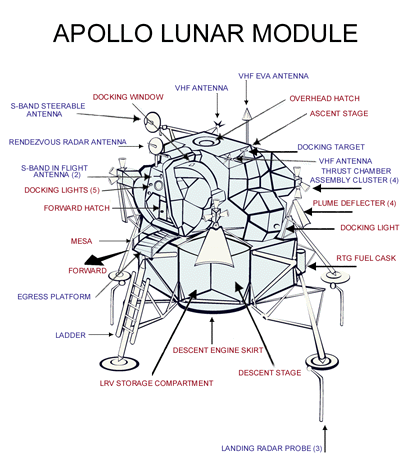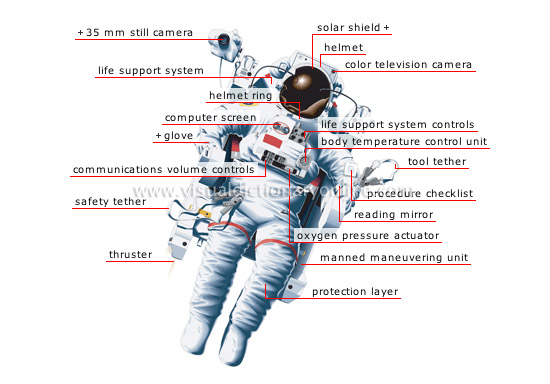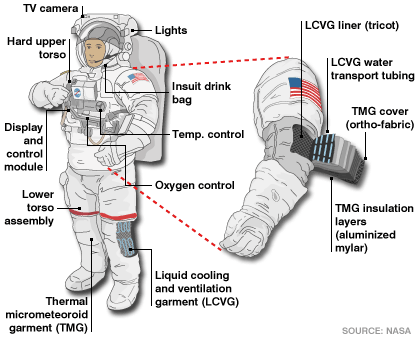Учебное пособие Астрономия. Космическая техника и технологии Алматы, 2012 удк 802. 0 52 629. 7 (0758) ббк 81. Англ. 923
 Скачать 1.02 Mb. Скачать 1.02 Mb.
|
|
The Lunar Module  The Apollo lunar module, or LM, was the first true spacecraft-designed to fly only in a vacuum, with no aerodynamic qualities whatsoever. Launched attached to the Apollo command/service module, it separated in lunar orbit and descended to the Moon with two astronauts inside. At the end of their stay on the surface, the lunar module's ascent stage fired its own rocket to rejoin the command/service module in lunar orbit. The Saturn launch vehicle and the Apollo spacecraft were difficult technological challenges, but the lunar module, the third part of the hardware for the Moon landing, represented the most serious problem. Begun a year later than it should have been, the lunar module was consistently behind schedule and over budget. Much of the problem turned on the difficulty of devising two separate components--one for descending to the surface of the Moon and one for returning to the command module. Both engines had to work perfectly or the very real possibility existed that the astronauts would not return home. The launch vehicle, the spacecraft, and the lunar module were manufactured many hundreds of miles from each other. Transported by specially fitted ocean-going ships and aircraft to the Kennedy Space Center, they came together for the first time in the huge Vehicle Assembly Building. In March 1969 the crew of Apollo 9 tested the third piece of Apollo hardware--the Lunar Module. For ten days, the astronauts put all three Apollo vehicles through their paces in Earth orbit, undocking and then redocking the lunar lander with the command module, just as they would in lunar orbit. Two of the astronauts performed a space walk, and one checked out the new Apollo spacesuit, the first to have its own life support system rather than being dependent on an umbilical connection to the spacecraft. This mission paved the way for a dress rehearsal for a Moon landing with Apollo 10 and the subsequent success of Apollo 11. Answer the questions: 1)Read James Webb's description of what was involved in landing a man on the Moon. What kinds of things do you think could have gone wrong? 2)Why do you suppose there were so many disputes within NASA about the method of flying to the Moon? 3)Even though the spacecraft that Gus Grissom, Edward White, and Roger Chaffee were supposed to fly never reached space, NASA formally designated it Apollo 1. Why do you think they did that? 4)What was the significance of Apollo 7? 5) What happened for the first time when Saturn V launched Apollo 8 to orbit the moon? What might that have been like for the people witnessing this historic moment? 6)Which of the three components do you think presented the greatest engineering challenges? Why? 7)Which was the most critical to the success of the Apollo mission? Text 11C Shuttle and ISS garb During ascent to and descent from orbit, Space Shuttle astronauts wear special orange partial pressure suits with helmet, gloves, and boots in case of a loss of cabin pressure. Once in orbit, crew members inside the Shuttle enjoy shirtsleeve comfort. To work in the Shuttle's open cargo bay or perform other tasks outside the spacecraft, they don spacesuits known as extravehicular mobility units (EMUs), more durable and flexible than any previous suits. The EMU is modular enabling it to be built up from a number of parts depending on the particular task in hand. Also, the upper torso, lower torso, arms, and gloves are not individually tailored but made in a variety of sizes that can be put together in combinations to fit any-sized crew member, man or woman. Each suit has supplies for a 6.5-hour spacewalk plus a 30-minute reserve and is pressurized to just under one third of atmospheric pressure. Before donning the suit, astronauts spend several hours breathing pure oxygen because the suit also uses 100% oxygen whereas the habitable decks on the Shuttle use an Earth-normal 21% oxygen/79% nitrogen mixture at atmospheric pressure (reduced to 0.69 atmospheres before an EVA). This preparation is necessary to remove nitrogen dissolved in body fluids to prevent its release as gas bubbles when pressure is reduced, a condition commonly called the bends.
Answer the questions: 1)When do Space Shuttle astronauts wear special orange partial pressure suits with helmet, gloves, and boots? 2) What advantages do extravehicular mobility units (EMUs) have? 3) Are the upper torso, lower torso, arms, and gloves individually tailored for each astronaut? 4) Why do astronauts spend several hours breathing pure oxygen before donning the suit? 5) What parts of the EMU go on first? 6)What does the astronaut pulls on the flexible lower torso assembly before rising into the stiff upper section which hangs on the wall of the airlock? 7) What does the upper torso (a hard fiberglass structure) contain? 8) Why are connections between the two parts very important? Listening “The Evolution of Spacesuits”  We are going to listen to Special English program about the special clothes astronauts wear that protect them while they work in space. For questions 1-17 complete the sentence: 1) A person cannot work in the extremes of space without many different kinds of ___. 2) ___ from the sun is another environmental risk in space. 3) An astronaut who does work outside the space shuttle usually is wearing more than ___ pieces of protective equipment. 4) At about ___ meters, the air is so thin and the amount of oxygen so small that a person needs a lot of special equipment to survive. 5) A well-known American flyer, Wiley Post, designed one of the first successful devices to protect a ___ at extreme heights in nineteen-thirty-three. 6) Astronauts in NASA’s Mercury Program flew the first American space flights in the early ___. 7) When air pressure filled the early spacesuit, astronauts found it difficult to move their ___ or ___. 8) Today, astronauts wear very different protective clothing. It lets them move, do useful tasks, and stay outside their spacecraft in comfort and safety for ___hours. 9) The EMU (extravehicular mobility unit) has a number of parts that an astronaut can link together by using only ___. 10) Wearing the whole EMU can add as much as ___ kilograms to your weight. 11) You will also wear something called the Liquid Cooling and Ventilation Garment. This piece of clothing is worn next to the skin. It helps keep the body ___ by moving water through many small tubes that cover the device. 12) A special hat on your head is made of soft cloth. It also carries several ___ devices including earphones and microphones. 13) The lower part of the spacesuit is next. It is called the Lower Torso Assembly. It is like putting on a large pair of pants that have boots built in the bottom of the ___. 14) The life support system supplies the oxygen needed for breathing and the air pressure necessary to protect your body. The upper part of the spacesuit also carries an emergency oxygen system in case the first system ___. 15) An important part of your spacesuit is the ___. It lets you observe and control your oxygen system. It is also the place you find the controls for your communications equipment. 16) NASA scientists are also considering the kind of spacesuits that would be needed for exploration on the planet Mars. Because of the gravity on Mars, spacesuits may have to be designed to be ___ than suits used in orbit or on the moon. 17) All of the spacesuits that have returned from space belong to the Smithsonian Institution. Most of the suits are stored in a building about ten kilometers from Washington. They are kept in a room where air temperature and moisture levels are carefully ___. Unit 12 People and Space Text 12 A Sally Ride By Sharon Fabian Sally Ride had the skills and the talent, and she loved science. She wasn't afraid to keep studying science, even when other girls decided that science was too hard, or when they said that science was a boys' subject. Sally Ride became so good at science that she got to be the first American woman in space. As a science student, she had many demanding subjects to study. Space scientists take advanced courses in math and sciences. They study topics like calculus and physics, and that is just the beginning. These are not easy subjects, but when you are studying something you enjoy, it may be hard work, but the hard work is often fun too. Sally Ride must have really enjoyed space science. She went on to get her bachelor's degree, her master's degree, and her doctorate in science. Her field was astrophysics. When she was 27 years old, Sally heard that NASA was looking for young men and women who were experts in science. At the time NASA wanted to hire 35 astronaut candidates. Sally applied for one of the jobs. At the time she wouldn't have had any way of knowing that 8,000 other men and women had applied too. Sally's application was one of the very best, and in 1978 she joined NASA and began astronaut training. Even though she was a science expert, Sally didn't know much about flying a spacecraft. So she had more subjects to learn. She learned about flying. She learned about navigation. She learned about radio communication. She went through training on weightlessness, water survival, and parachute jumping. Sally must have enjoyed these new subjects that she was learning too. She especially liked flying; it became her new favourite hobby. Sally did many different jobs for NASA. She worked as part of the ground crew for two Columbia flights, in 1981 and 1982. For those flights, she was a communications officer who sent radio messages back and forth between the ground crew and the shuttle itself. Sally was chosen to go on a space flight in 1983. She became an astronaut aboard the space shuttle Challenger. Her job there was mission specialist. A mission specialist does many different things during a space flight. One of the things Sally did on this flight was to test a robot arm in space. This flight made her famous, because she was the first American woman in space. Here is what she had to say about that flight. "I'm sure it was the most fun I'll ever have in my life." In 1984, Sally had the chance to go on a second space mission aboard Challenger. This time she spent eight days in space. All together, Sally spent 343 hours in space, a place most people can only dream of. In 1987, at the age of 36, Sally retired from NASA. She went on to other science jobs at major universities and science centers. She had a mission now too, but it wasn't to go into space this time. Now her mission was to get more girls interested in science and to encourage girls to study science when they moved on to high school and college. She began an organization to promote girls' interest in science. If you are interested, you can look up Imaginary Lines or the Sally Ride Club on the Internet. You can find her children's books in the library. Two of them are To Space and Back and Voyager: An Adventure to the Edge of the Solar System. With an approach like Dr. Ride's, most anything you can do with science is fun! Choose the correct answer: 1) Sally Ride was ___. a) the first American woman in space b) the first woman pilot c) the first woman to study science in college d) the first American in space 2) Sally Ride’s name became Dr. Ride when ___. a) she graduated from college b) she received her doctorate degree c) she joined NASA and began astronaut training d) she flew in the Challenger 3) Space scientists need to know a lot of math. a) True b) False 4) When Sally applied to be an astronaut, how many other people applied too? a) 35 b) 27 c) 1978 d) 8,000 5) Sally worked as a ground crew communication officer ___. a) after her second space flight b) before she went to college c) before she flew in space d) after she retired from NASA 6) All together, Sally spent a total of about ___ days in space. a) 12 b) 14 c) 10 d) 8 7) The article says that Sally’s field of study was astrophysics. What do you think the word “astrophysics” mean? a) the science of making or flying planes b) the science of how objects move through the air c) the science studying physical and chemical structure of the stars, planets and other objects in the universe d) the science studying stars, planets and other objects in the universe. Text 12B Neil Armstrong By Sharon Fabian When you are planning to go on a trip, you have to get things ready. You have to pack. If you're going to the beach for a vacation, maybe you pack swimsuits, shorts, and T-shirts, but you might also pack a few warm clothes in case it gets cold at night. If you're planning a trip to someplace you've never been before, maybe you do a little research to find out what the weather is usually like there. Maybe you pack something to read, something to play with, or some sports equipment. If you're going on a business or a study trip, you pack the materials that you will need while you are there. You might look up the best route on a map, or ask someone for directions. You might fill up the gas tank in your car, or buy a plane ticket. In 1969, Neil Armstrong was planning a trip. For this trip, he couldn't choose a route from a road map, and there was no one who had taken the same trip before, so he couldn't just ask for directions. Neil Armstrong was planning a trip to the moon. If the trip went as he planned, he would be the first person ever to set foot on the moon. Armstrong and the other scientists at NASA had a lot of planning to do. Since both the earth and the moon are always moving, it would take a lot of very precise math to figure out how to get there and back. The weather would be unpredictable, as always, and might cause last minute changes in their plans. They had to choose a landing site. Since no one had ever been on the moon's surface, they had to make a scientific guess about where would be a good place to land, and they chose a place named the Sea of Tranquility. They had to pack too. Armstrong and his crew, Michael Collins and Edwin "Buzz" Aldrin, would have to take everything they would need for their eight-day journey. Not only would they have to pack all of their food, they would also need to take their own water, and even their own oxygen! They would need to pack special equipment to deal with the weightlessness in space and the low gravity on the moon. They needed to plan how they would keep warm in space. They also packed equipment for science experiments, including a seismograph, -- used to detect earthquakes (or moonquakes) -- and a laser that could be used to calculate the exact distance from the earth to the moon. They took a camera, and containers to bring samples back to Earth. Planning for this trip also involved lots of training. The three astronauts had to relearn many everyday things. Simple activities like eating and moving around would require new skills in the weightless atmosphere of the spaceship. Finally it was time to go. Everything was ready, and the weather was right. On July 16, a huge Saturn V rocket blasted Armstrong, Collins, and Aldrin into orbit in their spacecraft, Apollo 11. For four days, they raced though space. Then, on July 20, while Collins orbited the moon in Apollo 11, Armstrong and Aldrin climbed into the Eagle, their lunar landing vehicle, and headed straight for the moon. The spot they had picked for a landing turned out to be too rocky, but the astronauts manoeuvred to a smoother area and landed. Armstrong was the first one to step out onto the moon. He had a short speech prepared for the occasion: "That's one small step for man, one giant leap for mankind." They took pictures of the moon, collected samples of moon rocks, set up their experiments, and all together spent just two and one-half hours on the moon. They left behind footprints that are probably still there today. Then they started on their journey home. On July 24 they splashed down in the ocean, safely back on earth. They must have been glad to be home, but what a trip it had been! |

